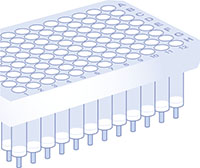CHROMABOND® XTR – SPE Cartridges
Kieselguhr phase for liquid-liquid extraction
Base material coarse-grained kieselguhr (also known as diatomaceous earth, hydromatrix, celite) large pore size, high pore volume, constantly high batch-to-batch quality pH working range 1-13
Application:
- Liquid-liquid extraction of highly viscous aqueous solutions such as physiological fluids (blood, plasma, and serum) in clinical chemistry, dyes in textiles, environmental and food analysis without the use of a separation funnel
- High water loadability without a breakthrough of water during elution with
organic solvents - Also suited for removing small amounts of water from solvents which are not miscible with water
Advantages:
- Fast, reproducible, and economical simultaneous preparation of several samples
- No problems with phase separation
- No formation of emulsions
- High recovery rates
- Saving of time and solvents
- Organic solutions need not be dried after separation

CHROMABOND® XTR
Solvents applicable for elution
- Diethyl ether
- tert butyl methyl ether
- Ethyl acetate
- n-hexane
- Cyclohexane
- Toluene
- Dichloromethane (methylene chloride)
- Trichloromethane (chloroform)
- Trichloromethane – methanol (90:10, v/v)
- Trichloromethane – methanol (85:15, v/v)
- Diethyl ether – ethanol (90:10, v/v)
- Diethyl ether – ethanol (80:20, v/v)
- Dichloromethane – 2-propanol (90:10, v/v)
- Dichloromethane – 2-propanol (85:15, v/v)

Eluents with too high alcohol contents cause an increase in volume of the aqueous phase on the CHROMABOND® XTR. Here the column could be overloaded and the aqueous phase displaced from the column. In this case, a greater capacity column should be used.
Depending on the concentration of the analytes, eluates can be analyzed immediately, or the organic solvent is evaporated. The pH value of the aqueous solution can be altered on the column, which enables elution of different compounds of a sample under optimized conditions. Under certain circumstances, acidic, neutral, and basic compounds can be fractionated in this way.

Plastic Columns
| Catalog No. | Description | Price (USD) |
|---|---|---|
| 730502 | SPE Cartridges, Chromabond, XTR, 3ml, PP, 500mg, 50/pk |  Buy now $108.00 Buy now $108.00 |
| 730487 | SPE Cartridges, Chromabond, XTR, 6ml, PP, 1g, 30/pk |  Buy now $71.00 Buy now $71.00 |
| 730487.250 | SPE Cartridges, Chromabond, XTR, 6ml, PP, 1g, 250/pk |  Buy now $474.00 Buy now $474.00 |
| 730489 | SPE Cartridges, Chromabond, XTR, 15ml, PP, 3g, 30/pk |  Buy now $83.50 Buy now $83.50 |
| 730505 | SPE Cartridges, Chromabond, XTR, 30ml, PP, 4.5g, 30/pk |  Buy now $91.30 Buy now $91.30 |
| 730506 | SPE Cartridges, Chromabond, XTR, 45ml, PP, 8.3g, 30/pk |  Buy now $99.10 Buy now $99.10 |
| 730507 | SPE Cartridges, Chromabond, XTR, 70ml, PP, 14.5g, 30/pk |  Buy now $188.00 Buy now $188.00 |
| 730507.100 | SPE Cartridges, Chromabond, XTR, 70ml, PP, 14.5g, 100/pk |  Buy now $492.00 Buy now $492.00 |
| 730509 | SPE Cartridges, Chromabond, XTR, 150ml, PP, 37.5g, 10/pk |  Buy now $115.00 Buy now $115.00 |
96 Well Plate
| Catalog No. | Description | Price (USD) |
|---|---|---|
| 738131.150M | SPE, Chromabond, 96 well plates, XTR, 150mg, 1/pk |  Buy now $240.00 Buy now $240.00 |
Accessories
| Catalog No. | Description | Price (USD) |
|---|---|---|
| 730508 | Chromabond 24 position collection rack, polypropylene, includes 24 PP stopcocks and 24 PP needles |  Buy now $885.00 Buy now $885.00 |
| Catalog No. | Description | Price (USD) |
|---|---|---|
| 730508 | Chromabond 24 position collection rack, polypropylene, includes 24 PP stopcocks and 24 PP needles |  Buy now $885.00 Buy now $885.00 |

For parallel processing of up to 24 CHROMABOND® XTR columns 1–150 mL we recommend the polypropylene rack (Cat. #730508) consisting of two side walls, a middle section including stopcocks and needles, a bottom part, and top part for stabilizing 45 mL and 70 mL CHROMABOND® XTR columns. This rack can be adjusted to various heights depending on the CHROMABOND® XTR columns and the collection vials used. Each position of the middle part is equipped with a polypropylene stopcock on the top (Cat. #730185) and a polypropylene needle on the bottom (Cat. #730154). For collection of the sample, we suggest the using vials, test tubes, or round bottom or tapered flasks.



